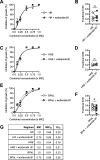Wollamide Cyclic Hexapeptides Synergize with Established and New Tuberculosis Antibiotics in Targeting Mycobacterium tuberculosis
- PMID: 37289062
- PMCID: PMC10433873
- DOI: 10.1128/spectrum.00465-23
Wollamide Cyclic Hexapeptides Synergize with Established and New Tuberculosis Antibiotics in Targeting Mycobacterium tuberculosis
Abstract
Shorter and more effective treatment regimens as well as new drugs are urgent priorities for reducing the immense global burden of tuberculosis (TB). As treatment of TB currently requires multiple antibiotics with diverse mechanisms of action, any new drug lead requires assessment of potential interactions with existing TB antibiotics. We previously described the discovery of wollamides, a new class of Streptomyces-derived cyclic hexapeptides with antimycobacterial activity. To further assess the value of the wollamide pharmacophore as an antimycobacterial lead, we determined wollamide interactions with first- and second-line TB antibiotics by determining fractional inhibitory combination index and zero interaction potency scores. In vitro two-way and multiway interaction analyses revealed that wollamide B1 synergizes with ethambutol, pretomanid, delamanid, and para-aminosalicylic acid in inhibiting the replication and promoting the killing of phylogenetically diverse clinical and reference strains of the Mycobacterium tuberculosis complex (MTBC). Wollamide B1 antimycobacterial activity was not compromised in multi- and extensively drug-resistant MTBC strains. Moreover, growth-inhibitory antimycobacterial activity of the combination of bedaquiline/pretomanid/linezolid was further enhanced by wollamide B1, and wollamide B1 did not compromise the antimycobacterial activity of the isoniazid/rifampicin/ethambutol combination. Collectively, these findings add new dimensions to the desirable characteristics of the wollamide pharmacophore as an antimycobacterial lead compound. IMPORTANCE Tuberculosis (TB) is an infectious disease that affects millions of people globally, with 1.6 million deaths annually. TB treatment requires combinations of multiple different antibiotics for many months, and toxic side effects can occur. Therefore, shorter, safer, more effective TB therapies are required, and these should ideally also be effective against drug-resistant strains of the bacteria that cause TB. This study shows that wollamide B1, a chemically optimized member of a new class of antibacterial compounds, inhibits the growth of drug-sensitive as well as multidrug-resistant Mycobacterium tuberculosis isolated from TB patients. In combination with TB antibiotics, wollamide B1 synergistically enhances the activity of several antibiotics, including complex drug combinations that are currently used for TB treatment. These new insights expand the catalogue of the desirable characteristics of wollamide B1 as an antimycobacterial lead compound that might inspire the development of improved TB treatments.
Keywords: Mycobacterium tuberculosis; antimicrobial combinations; multidrug resistance.
Conflict of interest statement
The authors declare no conflict of interest.
Figures



Similar articles
-
Structure-Activity Relationships of Wollamide Cyclic Hexapeptides with Activity against Drug-Resistant and Intracellular Mycobacterium tuberculosis.Antimicrob Agents Chemother. 2019 Feb 26;63(3):e01773-18. doi: 10.1128/AAC.01773-18. Print 2019 Mar. Antimicrob Agents Chemother. 2019. PMID: 30602509 Free PMC article.
-
[Development of antituberculous drugs: current status and future prospects].Kekkaku. 2006 Dec;81(12):753-74. Kekkaku. 2006. PMID: 17240921 Review. Japanese.
-
Activity of a new class of isonicotinoylhydrazones used alone and in combination with isoniazid, rifampicin, ethambutol, para-aminosalicylic acid and clofazimine against Mycobacterium tuberculosis.J Antimicrob Chemother. 2002 Feb;49(2):275-82. doi: 10.1093/jac/49.2.275. J Antimicrob Chemother. 2002. PMID: 11815568
-
Optimized Background Regimen for Treatment of Active Tuberculosis with the Next-Generation Benzothiazinone Macozinone (PBTZ169).Antimicrob Agents Chemother. 2018 Oct 24;62(11):e00840-18. doi: 10.1128/AAC.00840-18. Print 2018 Nov. Antimicrob Agents Chemother. 2018. PMID: 30126954 Free PMC article.
-
Recent updates on drug resistance in Mycobacterium tuberculosis.J Appl Microbiol. 2020 Jun;128(6):1547-1567. doi: 10.1111/jam.14478. Epub 2019 Oct 29. J Appl Microbiol. 2020. PMID: 31595643 Review.
Cited by
-
Harnessing Actinobacteria secondary metabolites for tuberculosis drug discovery: Historical trends, current status and future outlooks.Nat Prod Bioprospect. 2025 Aug 11;15(1):52. doi: 10.1007/s13659-025-00533-8. Nat Prod Bioprospect. 2025. PMID: 40788464 Free PMC article. Review.
References
-
- World Health Organization (WHO). 2022. Global Tuberculosis Report 2022. WHO, Geneva, Switzerland.
-
- Lin PL, Maiello P, Gideon HP, Coleman MT, Cadena AM, Rodgers MA, Gregg R, O’Malley M, Tomko J, Fillmore D, Frye LJ, Rutledge T, DiFazio RM, Janssen C, Klein E, Andersen PL, Fortune SM, Flynn JL. 2016. PET CT identifies reactivation risk in cynomolgus macaques with latent M. tuberculosis. PLoS Pathog 12:e1005739. doi:10.1371/journal.ppat.1005739. - DOI - PMC - PubMed
Publication types
MeSH terms
Substances
LinkOut - more resources
Full Text Sources
Medical
Research Materials

